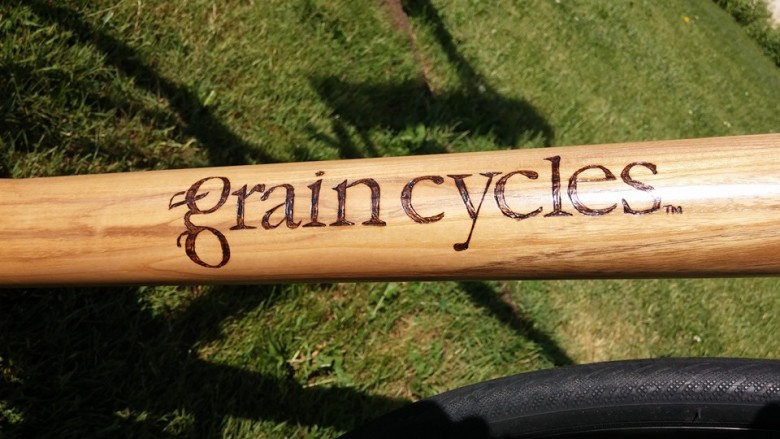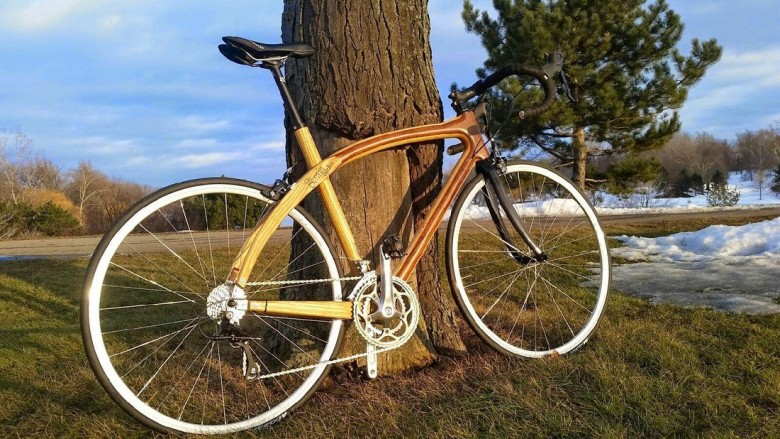There's something a-brewing in Studio #212 at the Niagara Arts and Cultural Center (1201 Pine Ave, Niagara Falls, NY 14301) that many Western New Yorkers will be excited to hear about. The brainchild of Against the Grain Woodworking's Victor Marwin and Peter Johnson, Grain Cycles have arrived to give the many cyclists and enthusiasts in the area a new aesthetically pure and extremely durable alternative to ride wherever the road takes them.
With a low carbon footprint (they are built from FSC certified sustainable lumber), centuries-old European craftsmanship, and multiple wood options spanning Ash, Cherry, Oak, and Maple, these bikes will set you apart and continue the great artistic conversation surrounding their genesis. And with a five-year guarantee from unlikely breaks, cracks, or structural instabilities through regular usage, you can't go wrong.
Both Victor and Peter are extremely enthusiastic about the endeavor and are jumping headfirst into the business end to ensure their product remains unique and effective for years to come. With two more models on the horizon to help bolster a stable already consisting of a "City Bike" and "Road Bike", the sky is the limit. And you only have to head over to their studio to experience these works of art yourself.
--
BuffaloVibe: Before jumping into Grain Cycles, I was hoping you could give us a little history about Against the Grain Woodworking.
Victor Marwin: I have been in woodworking for about forty years now. I came here fifteen years ago to the Niagara Arts and Cultural Center for space and I found [our studio] and then expanded a little bit. I prefer custom furniture building, but for the most part I've been doing a lot of restoration and repair because the market for custom in Western New York is kind of slim. Typically I get a couple pieces a year—maybe better than that working with some decorators and designers.
I started out woodworking at the Kittinger Furniture Company in the 70s where I pretty much was apprenticed—long story short.
And that's how Peter came on two years ago. He's been helping me out and I've been teaching him. He's picking it up remarkably fast and well.
Where did that relationship start? Were you looking for an apprentice or did Peter approach you?
VM: Every now and then I would look for somebody or somebody would look me up and try it, but basically they never worked out. Did you know that I'm Peter's uncle?
I did not know that.
VM: Yeah. So I've known him all his life. No introductions necessary here. [Laughter]
When he was about ten years old or so he'd say, "Uncle Vic, can I come and work in your shop?" And I'd say, "Well Pete, you have to be tall enough to work the machines." He's 6'4" now so he's tall enough and it's been working out great.
Peter's always had a knack for constructing things and self-engineering things. When a kid does it, it kind of blows up. But he was persistent and actually did a couple of cool projects that got the attention of a few adults including myself and his mom and dad of course. Now that he's graduated from school and been around the world a few times he has the passion and desire and definitely the skilled hands for it. He's come along great.
So I wasn't really looking, but when I realized he was serious we took it from there.
Peter, did you approach him often or did everything kind of come together for you to know you were ready?
Peter Johnson: I thought about trying it out for a couple of summers when I was in college, but you need a little more investment than just the summer. So I graduated from school, had a summer job, and once that season came to an end I decided to come over here full time.
And when did the idea for Grain Cycles come about?
PJ: The idea came shortly after I had begun with Victor. But it really didn't come to fruition until about a year into our [partnership]. So that was last Fall when we started to put some stuff together. Since then we've been improving and designing what's now a saleable model.
Is everything going to be made to order or will you eventually have a stock to sell?
PJ: We're building to order at this point. We don't do custom geometry per se, but the bicycle is custom for each person to select the species [of wood] and how it's set up.
VM: This is pretty early on in the whole game. We only have three bikes at this point that we can show as models for purchase. We're trying to iron out the business end of things. You've probably heard the old story of how you can be a craftsman but not a businessman. I'll make anything out of wood, but as far as that goes …
And that's a true statement: we will absolutely make anything out of wood. There's nothing that can't be constructed here. But the business side is kind of new to us and a little more complicated than we thought. We've brought somebody else on to take care of [that] aspect so it's pretty new with the Grain Cycles. But with Peter's enthusiasm and energy and my experience to help father something to fruition here—I certainly want him to take off with it and have a successful business—I think we're at a good start right now.
Could you compare the durability and performance of these bikes to the more traditional models on the market?
PJ: That will be where I come into play. Wood is an ancient building material—we've been using it forever. We know exactly how it's going to react or get abused with changes in weather and all that. It's stable—wood actually has a better fatigue life than metal and it's stronger by weight. Because of certain design characteristics we're not getting it quite as light, so they are a little heavier than other high-end bicycle frames out there currently.
VM: Not much, though.
PJ: They're actually more durable from impact and from stress, like a flex stress point of view. The wood we're using is used for baseball bats and axe handles so it's very tough. I think a lot of people have a difficult time picturing wood as anything more than—
VM: Furniture. You know?
The first time you see one of these bicycles—first of all everyone thinks they're beautiful. They are. They're absolutely beautiful. And let's face it: everyone loves wood.
They're hollow. There's a whole lot more going on in the construction than meets the eye and the durability is totally there. It flexes a little like a carbon fiber frame and they aren't as light, but they're pretty darn close. They're certainly not heavy or cumbersome.
Pete's put over a thousand miles on one of the bikes and hundreds more on the others and they're all as good as new. We're not having any problems. As you would do in the research and development stage, we've made a few minor changes after finding out what happens on the road. Nothing major.
It's difficult for people to wrap their heads around wood for a bicycle, but once you ride—and we’ve had some experienced riders try them out—there are no complaints at all. People love them.
Putting a thousand miles on the bike has to be the best advertising too. Showing it in action to people in the city.
PJ: Oh yeah.
What about Buffalo's weather conditions? Will they affect the bikes?
PJ: The finish that we're using on them is called spar varnish—
VM: It's what they use on boats.
PJ: So it's the same as a boat, which is submerged in water. But these will never be submerged.
VM: One time someone said, "I'd hate to take that out in the rain for one-hundred miles." Okay, you're not going to go for a hundred miles in the rain on any bike. You stay at home and put a movie on. But with the different types of finishes that we use, they are completely weather resistant. You don't leave a conventional bike out in raw weather. Nothing will happen in an immediate way like, "Don't let the water hit it." Not at all.
The varnish that Pete's talking about has been time-tested for over a hundred years. They put it on the nicest Chris Craft boats and as he said they are submerged in water and they're just beautiful. I have that finish on my own boat.
There are different choices of finish for different applications, but we're one hundred percent confident in wear and tear, the finishes, and going through the seasons—except for winter which it's not going to see. Nothing evil happens to it when you take it out. You just ride it like a regular bike.
PJ: The parts will rust and decay faster than the wood will. The metal parts any bicycle will have on it. Think of it like that.

Right now you have a "City Bike" and a "Road Bike". Are those going to be the only options going forward or are you experimenting with more models?
VM: We have a couple different options coming up.
PJ: We're developing a race bicycle right now and we're working on a cruiser model, but as has been stated we're still in our infancy. That's the idea at the moment, though—a couple models basically built to suit.
VM: We put a lot of handwork—a lot of love into each one of these bikes. It's not just an overnight thing, [but] it doesn't take a million years either.
As we develop them we make sure we build every single inch with all the integrity and characteristics and beauty of handwork on wood so that it shows in the end. The closer you get the better it looks and feels and rides and so on.
Custom woodwork of any type takes a little bit of time. I can see another six months to a year pass before we get a real line-up of decent models. We're talking about them and working on them daily and Pete's drawing. We have the cruiser and racer coming—more friendly sit-upright bikes for older people like myself.
It's fun but the development and research part takes some time. We have to be satisfied in our quality level and the bar's pretty high there.
What's the next planning stage?
PJ: We're in the process of getting these formerly tested by a third party—
VM: Buffalo State's technology department.
How can the public see what you have so far? Can they stop by the studio or do you attend different tradeshows around the area?
PJ: We've been going to a lot of the local bicycling events. We don't have a schedule of where we're going to be, but people are always welcome to stop by the studio and check them out Monday through Friday.
VM: I'm usually here Saturdays too.
Our studio is absolutely awesome. The building that we’re in [the NACC] is awesome. No one is ever disappointed when they come and visit here or visit us or see the bicycles. It's way cooler than you can talk about including the whole environment that we do this in. We welcome anybody at anytime. The door is always open for visitors.

